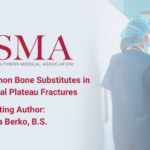Abstract | November 6, 2020
A Review of Common Bone Substitutes in Depressed Tibial Plateau Fractures
Learning Objectives
- This study aims to review the uses and efficacy of different demineralized bone matrix products as a bone graft substitute in the treatment of intra-articular tibial plateau fractures with a focus on understanding the manufacturing, delivery, utilization and efficacy of demineralized bone matrix.
Background/Knowledge Gap: Tibial plateau fractures with intra-articular depression as described by the Schatzker classification can lead to premature osteoarthritis due to involvement of the meniscus and articular surface. Demineralized bone matrix (DBM) and autologous bone grafts hold commonplace in open repair of fractures, however, there are many differences between the two types of products with a paucity of literature establishing a gold standard for their use in depressed tibial plateau fractures.
Methods/Design: A systematic literature review was performed using PubMed and eMendeley with the intent to understand current treatment standards and outcomes of patients with depressed tibial plateau fractures undergoing treatment with bone graft substitutes. Inclusion criteria for the study included all available literature on tibial plateau fractures, autografts, and allografts, specifically DBM. Keywords utilized in our search included “DBM”, “tibial plateau fractures”, “autografts”, “autograft complications.” Articles were selected from the 2000-2020 to reflect the progression that DBM has made in the treatment of tibial plateau fractures since its discovery in 1965.
Results/Findings: Harvesting autologous bone grafts can cause donor site pain, donor site infection, increased blood loss and increased operative time. In addition, autologous bone grafts are limited by volume, as the donor source is scarce. Autologous bone grafting is recognized as the gold standard among the types of bone grafting, however, demineralized bone matrix (DBM) has been also used as an allogeneic alternative to autologous bone grafting as it avoids many of the secondary complications from autologous bone grafts. DBM’s bone morphogenic proteins promote its osteoinductive ability on the surrounding mineral components. Compared to autologous bone grafting, DBM has the advantage of low risk of complication of donor site pain and infection, shortens the operative time, and is not limited to graft amount.
DBM is also cost efficient, as it has comparatively equal cost to autogenous bone grafts taken from the iliac crest. Few studies have been done comparing efficacy amongst DBM outcomes despite a wide array of available products. One study however compared two DBM products, Orthoblast and Grafton. Orthoblast was shown to have better treatment outcomes (P = 0.035). The difference in outcomes could be due to the variability in formulation and preparation of the different DBM products currently on the market.
Conclusion/Implications: There is a paucity of literature in comparison of DBM products as well as a lack of standardization for DBM products due to variabilities between manufacturers. Compared to many of the synthetic bone grafting alternatives, DBM may currently be at the forefront of significant tibial plateau fracture treatment outcomes, but requires allograft bone as a delivery vehicle. Nevertheless, further research is necessary to establish the efficacy, safety, consistency and reliability of its use in comparison to other bone graft options.

